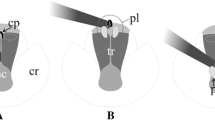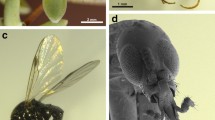Abstract
Leporella fimbriata is a self compatible orchid of southern Australia. It is dependant across its range on unique pollination by sexually attracted male winged antsMyrmecia urens, which pseudocopulate with the flower. Typical pollination sequences began with an initial circling then zig-zag flight to the flower. Vectors usually alighted on the inflorescence stem and quickly crawled to the flower where they adopted a copulatory position sideways along the wide labellum, pseudocopulatory probing immediately followed. In this position pollen carried on the thorax was deposited on the stigma. Departure from the labellum usually resulted in pollinium removal. Pollinator movements were restricted and the distribution leptokurtic with a mean of 3.141 ± 4.59 m. Pollination was widespread but variable from site to site and season to season with a maximum of 70% of all flowers being pollinated. Pollinator limitation is indicated. Traits essential for this pollination interaction include the coincidence of orchid and ant geographic distributions and the coincidence of flowering with the flight period of the ant. The production of pheromonelike substances and the distinctive floral morphology are also essential for attraction and manipulation of male ants. The ant mating system which the orchid can exploit is also important.
Similar content being viewed by others
References
Bates, R., 1979: Pollination of orchids. (10).Leporella fimbriata and its ant pollinators. — J. Native Orchid Soc. S. Australia3: (11), 9–10.
Beattie, A. J., Turnbull, C. L., Knox, R. B., Williams, E., 1984: Ant inhibition of pollen function: a possible reason why ant pollination is rare. — Amer. J. Bot.71: 421–426.
—, —,Hough, T., Jobson, S., Knox, B., 1985: The vulnerability of pollen and fungal spores to ant secretions: evidence and some evolutionary implications. — Amer. J. Bot.72: 606–614.
—, —, —,Knox, B., 1986: Antibiotic production: a possible function for the metaplural gland of ants (Hymenoptera: Formicidae). — Ann. Entomol. Soc. Amer.79: 448–450.
Bergstrom, G., 1978: Role of volatile chemicals inOphrys-pollinator interactions. — InHarbourne, J. B., (Ed.): Biochemical aspects of plant and animal coevolution, pp. 207–231. — London: Academic Press.
Browning, G. P., 1987: Taxonomy ofMyrmecia Fabricius (Hymenoptera: Formicidae). — Ph.D. thesis, University of Adelaide.
Clark, J., 1951: TheFormicidae of Australia 1. SubfamilyMyrmeciinae. — Melbourne, Australia: CSIRO.
Clements, M. A., 1982: Preliminary checklist of AustralianOrchidaceae. — Canberra: National Botanic Gardens.
Holldobler, B., 1971: Sex pheromone in the antXenomyrmex floridanus. — J. Insect Physiol.17: 1497–1499.
Jacobson, M., 1972: Insect sex pheromones. — London: Academic Press.
Kannowski, P. B., Johnson, R. L., 1969: Male patrolling behaviour and sex attraction in ants of the genusFormica. — Anim. Behav.17: 425–429.
Kullenberg, B., Bergstrom, G., 1973: The pollination ofOphrys orchids. — InBenz, G., Santesson, J., (Eds.): Chemistry in botanical classification, pp. 253–358. — Stockholm: Nobel Foundation.
—, —, 1976: The pollination ofOphrys orchids. — Bot. Not.129: 11–19.
Pate, J. S., Dixon, K. W., 1982: Tuberous, cormous and bulbous plants. — Nedlands: Univ. Western Australia Press.
Peakall, R., 1984: Observations on the pollination ofLeporella fimbriata (Lindl.)A. S. George. — J. Australasian Native Orchid Soc.8: 44–45.
- 1987: Genetic systems of Australian terrestrial orchids. — Ph.D. thesis, University of Western Australia.
—,James, S. H., 1989: Outcrossing in an ant pollinated clonal orchid. — Heredity62: 161–167.
—,Beattie, A. J., James, S. H., 1987: Pseudocopulation of an orchid by male ants: A test of two hypotheses accounting for the rarity of ant pollination. — Oecologia73: 522–524.
Stoutamire, W. P., 1974: Australian terrestrial orchids, thynnid wasps and pseudocopulation. — Amer. Orchid Soc. Bull.43: 13–18.
—, 1975: Pseudocopulation in Australian terrestrial orchids. — Amer. Orchid Soc. Bull.44: 226–233.
—, 1983: Wasp-pollinated species ofCaladenia in South-western Australia. — Austral. J. Bot.31: 383–394.
Wheeler, W. M., 1933: Colony-founding among ants. With an account of some primitive Australian species. — Cambridge, Mass.: Harvard University Press.
Wilson, E. O., 1971: The insect societies. — Cambridge, Mass.: Harvard University Press.
Woolcock, D. T., 1980: Wasps andLeporella fimbriata. — J. Australasian Native Orchid Soc.6: 157.
Author information
Authors and Affiliations
Rights and permissions
About this article
Cite this article
Peakall, R. The unique pollination ofLeporella fimbriata (Orchidaceae): Pollination by pseudocopulating male ants (Myrmecia urens, Formicidae). Pl Syst Evol 167, 137–148 (1989). https://doi.org/10.1007/BF00936402
Received:
Revised:
Issue Date:
DOI: https://doi.org/10.1007/BF00936402




